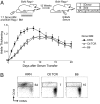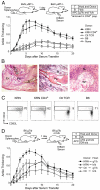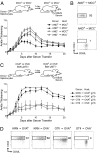IL-17-producing T cells can augment autoantibody-induced arthritis
- PMID: 19955422
- PMCID: PMC2799826
- DOI: 10.1073/pnas.0912152106
IL-17-producing T cells can augment autoantibody-induced arthritis
Abstract
Rheumatoid arthritis is a T lymphocyte-mediated disorder, but the precise nature of T cell involvement remains unclear. In the K/BxN mouse model of inflammatory arthritis, T cells initiate disease by providing help to B cells to produce arthritogenic autoantibodies. Here, we have characterized an additional, nonhumoral role for T cells in promoting autoantibody-induced arthritis. Autoreactive KRN T cells introduced either by direct transfer or bone marrow transplantation into B-cell-deficient hosts enhanced K/BxN serum-transferred arthritis, an effect that was dependent on expression of the cognate MHC-molecule/peptide complex. The T cell influence was dependent on interleukin (IL)-17; in contrast, standard serum-transferred arthritis, unenhanced by the addition of T cells, was unaffected by IL-17 neutralization. An IL-17-producing population of transferred KRN T cells was identified and found to be supported by the cotransfer of arthritogenic autoantibodies. IL-17-producing KRN T cells were enriched in inflamed joints of K/BxN mice, suggesting either selective recruitment or preferential differentiation. These results demonstrate the potential for autoreactive T cells to play two roles in the development of arthritis, both driving the production of pathogenic autoantibodies and bolstering the subsequent inflammatory cascade dependent on the innate immune system.
Conflict of interest statement
The authors declare no conflict of interest.
Figures






Similar articles
-
Th17 cells can provide B cell help in autoantibody induced arthritis.J Autoimmun. 2011 Feb;36(1):65-75. doi: 10.1016/j.jaut.2010.10.007. Epub 2010 Nov 13. J Autoimmun. 2011. PMID: 21075597 Free PMC article.
-
The cellular source and target of IL-21 in K/BxN autoimmune arthritis.J Immunol. 2013 Sep 15;191(6):2948-55. doi: 10.4049/jimmunol.1301173. Epub 2013 Aug 19. J Immunol. 2013. PMID: 23960240 Free PMC article.
-
Interleukin-4 can be a key positive regulator of inflammatory arthritis.Arthritis Rheum. 2005 Jun;52(6):1866-75. doi: 10.1002/art.21104. Arthritis Rheum. 2005. PMID: 15934072
-
The KRN mouse model of inflammatory arthritis.Springer Semin Immunopathol. 2003 Aug;25(1):79-90. doi: 10.1007/s00281-003-0131-5. Springer Semin Immunopathol. 2003. PMID: 12904893 Review.
-
Initiation of an autoimmune response: insights from a transgenic model of rheumatoid arthritis.Immunol Res. 2005;32(1-3):5-13. doi: 10.1385/IR:32:1-3:005. Immunol Res. 2005. PMID: 16106055 Review.
Cited by
-
Ssu72 Dual-Specific Protein Phosphatase: From Gene to Diseases.Int J Mol Sci. 2021 Apr 6;22(7):3791. doi: 10.3390/ijms22073791. Int J Mol Sci. 2021. PMID: 33917542 Free PMC article. Review.
-
Th17 cells can provide B cell help in autoantibody induced arthritis.J Autoimmun. 2011 Feb;36(1):65-75. doi: 10.1016/j.jaut.2010.10.007. Epub 2010 Nov 13. J Autoimmun. 2011. PMID: 21075597 Free PMC article.
-
Autoantibody-mediated arthritis in the absence of C3 and activating Fcγ receptors: C5 is activated by the coagulation cascade.Arthritis Res Ther. 2012 Dec 13;14(6):R269. doi: 10.1186/ar4117. Arthritis Res Ther. 2012. PMID: 23237573 Free PMC article.
-
CD4+ CCR6+ T cells, but not γδ T cells, are important for the IL-23R-dependent progression of antigen-induced inflammatory arthritis in mice.Eur J Immunol. 2020 Feb;50(2):245-255. doi: 10.1002/eji.201948112. Epub 2019 Nov 28. Eur J Immunol. 2020. PMID: 31778214 Free PMC article.
-
Modulation of IL-17 and Foxp3 expression in the prevention of autoimmune arthritis in mice.PLoS One. 2010 May 10;5(5):e10558. doi: 10.1371/journal.pone.0010558. PLoS One. 2010. PMID: 20479941 Free PMC article.
References
Publication types
MeSH terms
Substances
Grants and funding
LinkOut - more resources
Full Text Sources
Medical
Molecular Biology Databases
Research Materials

